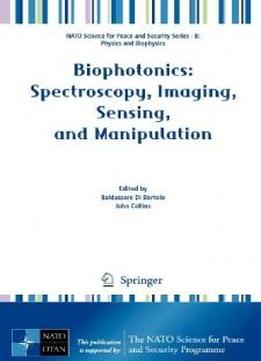
Biophotonics: Spectroscopy, Imaging, Sensing, And Manipulation (nato Science For Peace And Security Series B: Physics And Biophysics)
by John Collins /
2010 / English / PDF
13.1 MB Download
This volume describes an impressive array of the current
photonic-related technologies being used in the investigation of
biological systems. The topics include various types of microscopy
(fluorescence correlation microscopy, two-photon microscopy),
sensitive detection of biological molecules, nano-surgery
techniques, fluorescence resonance energy transfer,
nano-plasmonics, terahertz spectroscopy, and photosynthetic energy
conversion. The emphasis is on the physical principles behind each
technique, and on examining the advantages and limitations of
each.The book begins with an overview by Paras Prasad, a leader in
the field of biophotonics, of several important optical techniques
currently used for studying biological systems. In the subsequent
chapters these techniques are discussed in depth, providing the
reader with a detailed understanding of the basic physical
principles at work. An excellent treatment of terahertz
spectroscopy demonstrates how photonics is being extended beyond
the visible region. Recent results in the use of femtosecond lasers
as a tool to porate cell walls demonstrate that the manipulation of
light can be used as a tool for the study and the treatment of
biological systems. The field of Bio-photonics is broad and still
growing, so cannot be covered comprehensively in one volume. But
here the reader will find an introduction to some of the major
tools used for studying biological systems, and at the same time a
detailed, first-principles treatment of the physics behind these
tools.
This volume describes an impressive array of the current
photonic-related technologies being used in the investigation of
biological systems. The topics include various types of microscopy
(fluorescence correlation microscopy, two-photon microscopy),
sensitive detection of biological molecules, nano-surgery
techniques, fluorescence resonance energy transfer,
nano-plasmonics, terahertz spectroscopy, and photosynthetic energy
conversion. The emphasis is on the physical principles behind each
technique, and on examining the advantages and limitations of
each.The book begins with an overview by Paras Prasad, a leader in
the field of biophotonics, of several important optical techniques
currently used for studying biological systems. In the subsequent
chapters these techniques are discussed in depth, providing the
reader with a detailed understanding of the basic physical
principles at work. An excellent treatment of terahertz
spectroscopy demonstrates how photonics is being extended beyond
the visible region. Recent results in the use of femtosecond lasers
as a tool to porate cell walls demonstrate that the manipulation of
light can be used as a tool for the study and the treatment of
biological systems. The field of Bio-photonics is broad and still
growing, so cannot be covered comprehensively in one volume. But
here the reader will find an introduction to some of the major
tools used for studying biological systems, and at the same time a
detailed, first-principles treatment of the physics behind these
tools.











